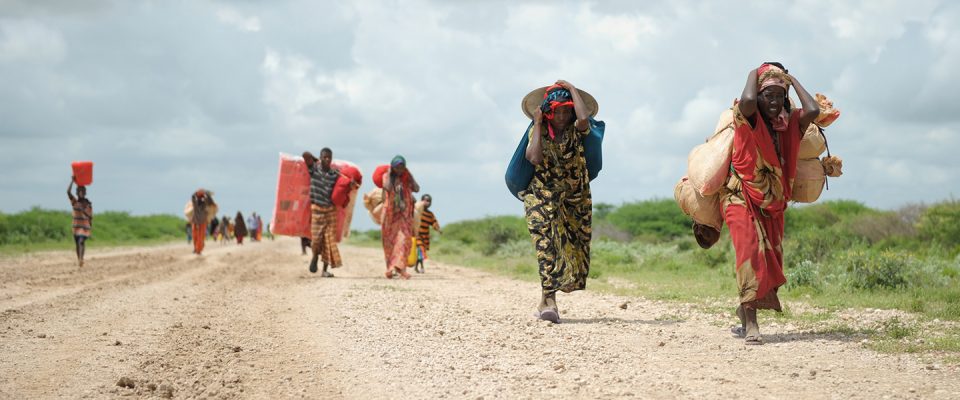Global levels of displacement have been steadily rising for the past decade and show no signs of slowing.
A record 120 million people are now estimated to be forcibly displaced. Conflicts in the Democratic Republic of Congo, Ethiopia, Myanmar, Palestine, Sudan, Syria, Ukraine and Yemen, among others, have contributed to these record figures. But severe weather events and natural disasters have also played a role.
The sheer numbers of displaced people have attracted global attention within political and media circles – reinforced in large part by anti-immigration policy agendas as well as humanitarian campaigns seeking to attract funding for neglected crises.
Unfortunately, the numbers overlook the individual experiences and needs of those who are displaced. The use of labels – such as ‘refugee’, ‘host’, ‘diaspora’, ‘returnee’, ‘asylum seeker’ – also fail to reflect the diversity of people affected by displacement, and more problematically, distance us from their personal experiences – especially where they may challenge existing assumptions or norms.
In the wake of this year’s Refugee Week, we’re carving out an opportunity to direct more attention to groups of people who are overlooked and unheard. We’ve been centring our recent research on less visible groups who routinely miss out on the attention and support they deserve – such as internally displaced persons (IDPs), refugee-led organisations (RLOs) and displaced people with diverse sexual orientation, gender identity and expression and sex characteristics (SOGIESC).
Internally displaced persons
Internal displacement consistently attracts less attention from policymakers and practitioners, even though the number of IDPs has grown by 50% in the last five years to 75.9 million. In recent years, there has been a noticeable shift in policy momentum around internal displacement – as illustrated by the 2019 High-Level Panel on Internal Displacement and its Action Agenda; the establishment of the Office of the Special Adviser on Solutions to Internal Displacement in 2022; and HPG’s 2024 Independent review of the humanitarian response to internal displacement, commissioned by the Inter-Agency Standing Committee (IASC). In spite of this policy progress, the international community has not succeeded in shifting the needle in IDP responses.
‘It is time that we work alongside [IDPs] as rightsholders’, and this means fully recognising their agency and the importance of their input. In the Independent review, we recommended that national governments and aid agencies need to ‘better lay the groundwork for solutions’. To support this, HPG is embarking on a three-year research programme (2024–2027) centred on the livelihoods of urban IDPs. This builds on previous HPG research on climate change, conflict and urban internal displacement and livelihoods in displacement. By developing a richer understanding of IDPs’ priorities and strategies, this new research considers what aid actors can do differently or better to support IDPs to build their own livelihoods, on their own terms.
Refugee-led organisations
Refugee-led organisations (RLOs) are a crucial cog in the refugee-response machine, providing essential services to their communities, as well as being more likely to lead responses that are accountable, legitimate, transparent, effective and impactful. In spite of this, they are not being given the funding and, by extension, the recognition and influence, they need and deserve. The available data shows that just $26.4 million of humanitarian and development funding reached RLOs in 2022. Average grant sizes to RLOs are only $26,657 – 10 times smaller than those received by local/national non-governmental organisations.
These failures are a missed opportunity that goes beyond a narrow focus on funding. They are symptomatic of a wider failure to localise humanitarian funding, all of which is at odds with principles of localisation, accountability and refugee leadership. Between 2023 and 2028, our research on financing refugee leadership and agency aims to identify and understand the barriers and challenges that RLOs and funders face, as well as to shine a light on opportunities for best practice when these occur. By providing snapshots of funding over time, based on rigorous and independent research, we are advocating for funders, who are at the centre of power, to transform the system from the inside.
Displaced people with diverse SOGIESC
Displacement amplifies pre-existing vulnerabilities and gender inequalities, exposing people of different genders and sexual orientations to multiple and intersecting needs. LGBTQI+ refugees, for example, endure the burden of twin stigma deriving from their gender and sexuality and their status as a refugee or displaced person. Research shows that displaced people with diverse SOGIESC face double or even triple exclusions, often putting them in a situation of greater risk and vulnerability. Once displaced, people with diverse SOGIESC – in particular transgender people – face additional challenges, such as violence and limited assistance and housing. Syrian trans women refugees in Lebanon, for example, continue to face extreme forms of violence, discrimination, stigmatisation and death.
While there has been some progress in implementing gender-responsive programming, significant gaps remain. ODI research shows that the humanitarian system is oblivious to the intersecting needs of displaced people with diverse sexual and gender identities. Existing tools, frameworks and guidance often adopt a heteronormative and binary approach that fail to reflect diverse groups and their specific risks. Over the next three years, HPG will undertake research in partnership with networks and organisations of people with diverse SOGIESC to better understand their risks and vulnerabilities and to address these gaps in evidence.
Through our continuing work with and in relation to these groups, we hope to encourage a more informed and inclusive understanding of the impacts of displacement for all of those affected – leading to a better outcome for all those fleeing danger.

